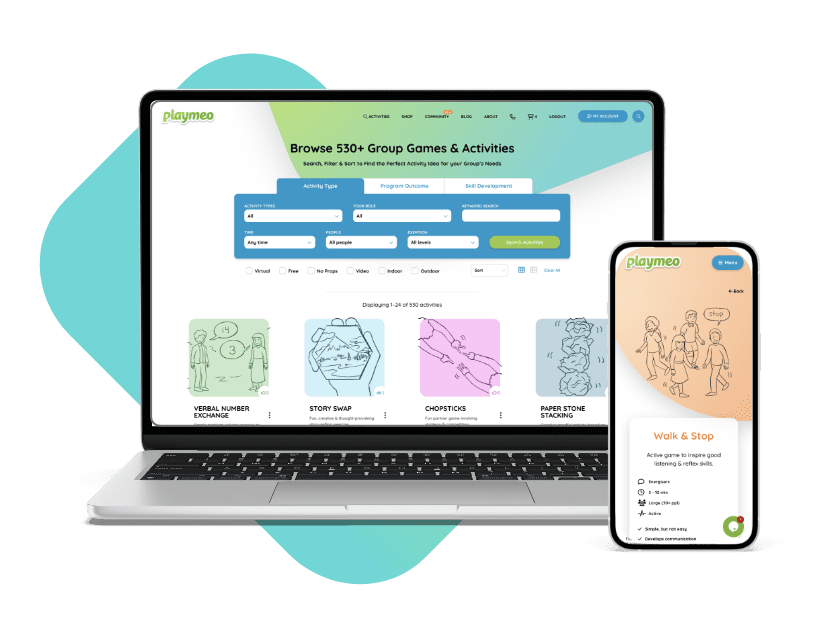Download our free 28-page ebook jam-packed with outrageously fun activity ideas.
Are you the sort of leader who follows their gut and delivers what you think your group needs in the moment, or do you prefer to stick with what’s written down, perhaps following your pre-planned program agenda?
A recent conversation inspired this question when a fellow educator asked me: Of all the skills of a group facilitator, which one is the most valuable?
This article will reveal my answer, but first, I want to take you on a journey to help you identify where along the facilitation spectrum you may lie.
An Early Illustration
One of my earliest mentors was Karl Rohnke, an absolute legend and extraordinary adventure programmer. I looked up to Karl and emulated him in many ways. And why wouldn’t I – everything he touched seemed to turn to gold.
I had the privilege of working alongside Karl on many occasions, especially in my first 6-months of training. Karl had been in the game for at least 20 years at this stage of his career, so I had much to learn about facilitation and program design.
One particular occasion epitomised the difference in our two approaches to facilitation that I loosely see as a spectrum.
We were about to lead a group of 30+ people on a 5-day residential training. Karl was very confident in his abilities, but as his less-experienced side-kick, I needed to know what I would be doing to contribute as much as possible. It was clear (to both of us) that Karl could deliver the workshop on his own, but I was here to learn so I needed a map (so to speak) to follow.
Before we started, I encouraged him to sit down with me so we could plan the sequence of every activity for the first hour or so of our program. As we got up to walk outside and meet our group, we were both very clear about who was doing what and when.
Then, in a moment, everything changed. Karl greeted the group, and introduced something completely off-script. Eeeek.
It was as if we had never had the discussion. The program sequence we discussed disappeared, and I was left floundering. I did my best to keep up with Karl’s thinking, but it was super-clear that Karl enjoyed making stuff up as he went along, whereas I required the safety blanket of a pre-planned sequence of events.
Which Approach Is Better?
This is an invalid question because both leadership styles have benefits and limitations.
Interestingly, the preferences I describe above operate in reverse for me these days. I note that in recent years when others work with me, my co-facilitators sometimes have difficulty embracing my ‘ad-hoc’ approach, ie this was me 30+ years ago.
This, of course, did not happen overnight. It was a gradual process as my confidence grew and my activity repertoire expanded, ie I had a greater ability to present the right activity at the right time.
Embracing a very flexible, ad-hoc and planning-on-the-run approach to program leadership allows me/you to be nimble and respond to our group’s needs immediately. Importantly, it allows us to focus on our group and their needs, which I regard as critical to making a difference in the lives and performance of the groups I work with.
On the other hand, following a predetermined plan helps me to understand the arc (or journey) of the program I am leading, which is useful when I am tempted to be distracted by what I call the ‘shiny object’ syndrome. That is, when we focus on what we are supposed to be doing, we are less likely to get carried away with the momentum of the group travelling in a different direction.
Both Eyes Open
In truth, I believe you need a foot in both camps.
You need one eye focused on the group’s needs and the sensations they are experiencing, and another on the overall arc of the program in terms of what you initially planned to be useful to achieve the group’s goals.
Thirty-three years into my professional career, this is what I do:
- Start by articulating the difference I want to make to the group I am about to work with;
- Jot down a few ideas of possible activities that will help me achieve this result, with a possible starting sequence; and
- Once I start, I constantly read my group for signs that I am on track or need to adjust my course, eg present different activities.
These three bullet points simply what is a very complex web of thoughts and algorithms that are spinning in my head at all times, but they capture the essence of my approach to facilitation.
The Most Valuable Facilitation Skill?
To read a group.
It’s that simple and that hard.
Yes, you are wise to think ahead about the arc of your program and what activities and experiences it may comprise (possibly in advance of even meeting your group.)
But equally, you are wise to look up from your agenda frequently to look at your group and determine if what you thought you could be doing next is the right thing to do.
This brings me to suggest two more critical skills of facilitation:
- Chop wood, carry water, or, in other words, ‘do the work’ over and over and over again. You cannot expect to build your confidence as an educator or group facilitator unless you have led 100s of programs with many, many groups. If you’d like to learn more about this concept of “chop wood, carry water” check out Joshua Medcalf’s book of the same name.
- Expanding your repertoire of group games & activities to increase the chances that you will introduce the right activity at the right time. That is to say, if your only tool is a hammer, then every problem is a nail. But if you intentionally build a massive collection of group activities that you can call on at a moment’s notice, you will have so many more tools to apply to solve a wider array of problems.
Expand Your Activity Repertoire Today
When you join playmeo’s exclusive learning community, you’ll unlock access to the world’s largest online database of group games & activities. The more activities you learn, the more likely you are to call on the right activity at the right time to help your group connect and grow.
To join today, click the button below.
Not sure if playmeo is for you? Start a 7-Day Free Trial to try before you buy.













thaaaaanks for this, mark!
i super appreciate the metaphor of using the hammer and the nail, and the analogy of ‘building something’ – to me, this IS the difference we want to make – that people can experience being something; that together, we are able to create something, and have lots of shared funn along the way.
would looooove to read an article (or two, smiiiiile) about the range of ways people prepare before they engage with a group – their rituals, habits, how to integrate feedback and reflection, preparing for potential conflict, resistance, et al…..
apologies if you already have this. winq winq
sending best viiiiibes to you for an eventful week ahead. hope the rest of your trip is as eventful as the way you started it.
looking forward to our monthly live member support session.
(“,)
jeWElle
‘thinking aloud’ – i wonderrrrr – what are the possibilities that there might be a third plan? plan a/b? plan 3.0? or harry potter’s train platform?
(“,)
Thanks for commenting JeWElle – undoubtedly there are many other options between these two extremes, and of course, it is always contextual.
Love the idea JeWElle, I’ll add it to the list
mark, merciiiii!
(“,)